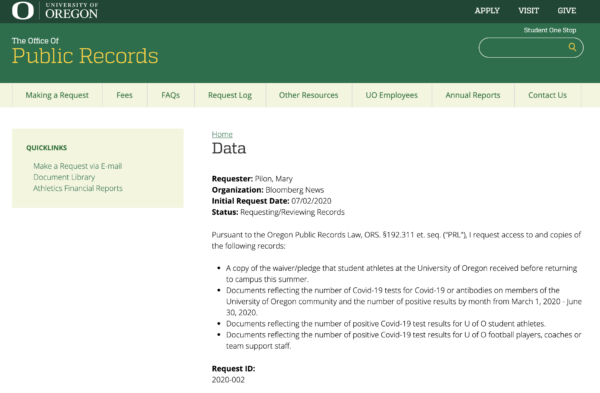9/16/2020, link here: 5/7/2020: Admins present Coronavirus Town Hall II, Now live and embedded: For an alternative view, read this blog, published by Melissa Graboyes, a UO professor and expert in public health.
Posts tagged as “Coronavirus”
(Except a few lab and performance classes). That’s the rumor down at the faculty club. Apparently the dorms will stay open. Here’s hoping JH’s well-paid strategic communicators have the good sense not to blame this on our students. Or the faculty. Or the staff. Or the unions. On Thursday, the…
8/11/2020 update: UO still hasn’t responded to the July 2nd request from Bloomberg News, but they’ve finally told the Oregonian this: “UO also said it “does not possess documents” regarding the number of positive COVID-19 test results for football players, coaches or team support staff, but that if they did,…
I can’t imagine why our provost would feel the need to put that in writing. I think the gist of his email is that faculty can now opt out of in-person teaching, whether they are obese or not: Dear Colleagues, I hope that you and your families are enjoying the…
More than a month now:
The gist is a list of “criteria” that includes no actual criteria, standards, numbers, trends, required first or second derivative signs, or any other metrics.
So it’s gonna be a judgement call, and Provost Phillips is not going to disclose what criteria actually need to be met to reopen in-person teaching at UO:
On or before August 26, the university will make a decision about whether to alter our plans and either more significantly reduce the number of in-person courses or transition to a fully remote model for the fall. This decision will be based on public health guidance and the following criteria:
- Indications of increasing community spread
- County reopening phase level
- Rate of county rapid testing turnaround times, and capacity for UO to provide testing to help sustain county needs
- Capacity of contact tracing and case management at health authority, for example Lane County Public Health (LCPH) in Eugene, including UO contact tracing resources assigned to support LCPH
- Implementation of protocols for enforcement of behavioral interventions, especially face coverings
- Capacity of on-campus self-isolation space for students living in University Housing
- Access to and availability of personal protective equipment needed to remain operational
- Ability to maintain proper levels of cleaning and sanitation
- Status of local K-12 schools and impacts on university personnel
Meanwhile UO’s Public Records Office is still delaying the release of basic testing data:
Full text online here and below the break:
7/5/2020: In the RG letters: As an alumnus, I strongly object to the decision by the University of Oregon to hide any information about the number of athletes testing positive for coronavirus. Why? One, the decision represents a disservice to, and potentially puts at risk, other members of the team…
Who would have guessed. From today’s email from the University of Oregon, here. Also: The university has approved a new self-check health regulation which outlines that students and employees should conduct a self-check daily and not come to campus if they are experiencing or have experienced any COVID-19 symptoms in the…
Ken Goe has the story in the Oregonian, here. The UO website revealed Thursday that five members of the campus community have tested positive. Some schools, among them Pac-12 rivals Colorado, Oregon State and Washington, have released information about the number of athletes to test positive this month. Colorado reported…
Full results and open-source docs, so that other universities to use the survey are now posted here. The survey was done by Melissa Graboyes, Ph.D., MPH Associate Professor, Medical History & African History Clark Honors College. Here’s the gist from her website: The UO Fall Survey ran from June 3-11.…
Thanks to an anonymous source for the leak: From: Janet Woodruff-Borden <janetw@uoregon.edu> Date: June 16, 2020 at 7:05:16 PM EDT To: Brad Shelton <shelton@uoregon.edu>, Bruce Blonigen <bruceb@uoregon.edu>, DD Humanities <ddhumanities@uoregon.edu>, Gabe Paquette <paquette@uoregon.edu>, Hal Sadofsky <sadofsky@uoregon.edu>, Janet Woodruff-Borden <janetw@uoregon.edu>, Juan-Carlos Molleda <jmolleda@uoregon.edu>, Karen Ford <fordk@uoregon.edu>, Kate Mondloch <mondloch@uoregon.edu>, Laura Vandenburgh…
Update: This survey will close at midnight Wed June 10. The UO administration isn’t going to do this, and few people would trust them to accurately report the results if they did. So this survey comes from UO Professor Melissa Graboyes. with the support of United Academics. Here’s more info and…
This program has been around for years as a way for employers to reduce hours for a group of employees, rather than layoff a few of them. Normally it’s a mixed bag – employees have their hours and pay reduced by 20-40%, and then get back about 2/3rds of the…
The decisions about UO’s financial and academic response to the coronavirus and its long term consequences are being made by Pres Mike Schill, Provost Patrick Phillips, BoT Secretary Angela Wilhems, VPBP Brad Shelton, CAS Dean Bruce Blonigen, and VPFA Jamie Moffitt in secret. The idea that they would use this…
Dear University of Oregon community, We all recognize the profound impact that the COVID-19 pandemic has had on both the University of Oregon and the national higher education landscape. The simple truth is that the coronavirus is an invisible disruptor that suddenly and harshly threatened what has been the UO’s…
